Advertisements
Online Mock Tests
Chapters
2: Exponents
3: Squares and Square Root
4: Cubes and Cube Roots
5: Playing with Numbers
▶ 6: Sets
7: Percent and Percentage
8: Profit, Loss and Discount
9: Interest
10: Direct and Inverse Variations
11: Algebraic Expressions
12: Identities
13: Factorisation
14: Linear Equations in one Variable
15: Linear Inequations
16: Understanding Shapes
17: Special Types of Quadrilaterals
18: Constructions
19: Representing 3-D in 2-D
20: Area of a Trapezium and a Polygon
21: Surface Area, Volume and Capacity
22: Data Handling
23: Probability
![Selina solutions for Concise Mathematics [English] Class 8 ICSE chapter 6 - Sets Selina solutions for Concise Mathematics [English] Class 8 ICSE chapter 6 - Sets - Shaalaa.com](/images/concise-mathematics-english-class-8-icse_6:3b78c4422443458583dde48f228ef792.jpg)
Advertisements
Solutions for Chapter 6: Sets
Below listed, you can find solutions for Chapter 6 of CISCE Selina for Concise Mathematics [English] Class 8 ICSE.
Selina solutions for Concise Mathematics [English] Class 8 ICSE 6 Sets Exercise 6 (A) [Page 65]
Write the following set in roster (Tabular) form:
A1 = {x : 2x + 3 = 11}
Write the following sets in roster (Tabular) form :
A2 = {x : x2 - 4x -5 = 0}
Write the following sets in roster (Tabular) form:
A3 = {x : x ∈ Z, -3 ≤ x <4}
Write the following sets in roster (Tabular) form :
A4 = {x : x is a two digit number and sum of digits of x is 7}
Write the following sets in roster (Tabular) form :
A5 = {x : x = 4n, n ∈ W and n < 4}
Write the following sets in roster (Tabular) form :
A6 = {x : x = `n/(n+2)`; n ∈ N and n > 5}
Write the following sets in set-builder (Rule Method) form:
B1 = {6, 9, 12, 15 ....}
Write the following sets in set-builder (Rule Method) form :
B2 = {11, 13, 7, 19}
Write the following sets in set-builder (Rule Method) form :
B3 = `{1/3, 3/5, 5/7, 7/9, 9/11, ....}`
Write the following sets in set-builder (Rule Method) form :
B4 = {8, 27, 64, 125, 216}
Write the following sets in set-builder (Rule Method) form :
B5 = {-5, -4, -3, -2, -1}
Write the following sets in set-builder (Rule Method) form :
B6 = {....., -6, -3, 0, 3, 6 ......}
Is {1, 2, 4, 16, 64} = {x : x is a factor of 32}? Give reason.
Is {x : x is a factor of 27} ≠ {3, 9, 27, 54} ? Give reason.
Write the set of even factors of 124.
Write the set of odd factors of 72.
Write the set of prime factors of 3234.
Is {x : x2 – 7x + 12 = 0} = {3, 4} ?
Is {x : x2 – 5x – 6 = 0} = {2, 3} ?
Write the following sets in Roster form:
The set of letters in the word ‘MEERUT’
Write the following sets in Roster form:
The set of letters in the word ‘UNIVERSAL’.
Write the following sets in Roster form:
A = {x : x = y + 3, y ∈N and y > 3}
Write the following sets in Roster form:
B = {p : p ∈ W and p2 < 20}
Write the following sets in Roster form:
C = {x : x is composite number and 5 ≤ x ≤ 21}
List the elements of the following sets:
{x : x2 – 2x – 3 = 0}
List the elements of the following sets:
{x : x = 2y + 5; y ∈ N and 2 ≤ y < 6}
List the elements of the following sets:
{x : x is a factor of 24}
List the elements of the following sets:
{x : x ∈ Z and x2 ≤ 4}
List the elements of the following sets:
{x : 3x – 2 ≤ 10, x ∈ N}
List the elements of the following sets:
{x : 4 – 2x > -6, x ∈ Z}
Selina solutions for Concise Mathematics [English] Class 8 ICSE 6 Sets Exercise 6 (B) [Pages 67 - 68]
Find the cardinal number of the following sets:
A1 = {-2, -1, 1, 3, 5}
Find the cardinal number of the following sets:
A2 = {x : x ∈ N and 3 ≤ x <7}
Find the cardinal number of the following sets:
A3 = {p : p ∈ W and 2P - 3 < 8}
Find the cardinal number of the following sets:
A4 = {b : b ∈ Z and -7 < 3b -1 ≤ 2}
If P = {P : P is a letter in the word “PERMANENT”}. Find n (P).
State the following sets are finite or infinite:
A = {x : x ∈ Z and x < 10}
State the following sets are finite or infinite:
B = {x : x ∈ W and 5x -3 ≤ 20}
State the following sets are finite or infinite:
P = {y : y = 3x -2, x ∈ N & x > 5}
State the following sets are finite or infinite:
M = {r : r = `3/"n"`; n ∈ W and 6 < n ≤ 15}
Find, if the following sets are singleton sets:
The set of points of intersection of two non-parallel st. lines in the same plane
Find, if the following sets are singleton sets:
A = {x : 7x – 3 = 11}
Find, if the following sets are singleton sets:
B = {y : 2y + 1 < 3 and y ∈ W}
Find, if the following sets are empty:
The set of points of intersection of two parallel lines.
Find, if the following sets are empty:
A = {x : x ∈ N and 5 < x < 6}
Find, if the following sets are empty:
B = {x : x2 + 4 = 0, x ∈ N}
Find, if the following sets are empty:
C = {even numbers between 6 & 10}
Find, if the following sets are empty:
D = {prime numbers between 7 & 11}
Are the sets A = {4, 5, 6} and B = {x : x2 – 5x – 6 = 0} disjoint?
Are the sets A = {b, c, d, e} and B = {x : x is a letter in the word ‘MASTER’} joint?
State, if the following pair of a set is equivalent or not:
A = {x : x ∈ N and 11 ≥ 2x – 1} and B = {y : y ∈ W and 3 ≤ y ≤ 9}
State, if the following pair of a set is equivalent or not:
Set of integers and set of natural numbers.
State, if the following pair of a set is equivalent or not:
Set of whole numbers and set of multiples of 3.
State, if the following pair of a set is equivalent or not:
P = {5, 6, 7, 8} and M = {x : x ∈ W and x < 4}
State, if the following pair of a set is equal or not :
A = {2, 4, 6, 8} and B = {2n : n ∈ N and n < 5}
State, if the following pair of a set is equal or not :
M = {x : x ∈ W and x + 3 < 8} and N = {y : y = 2n -1, n ∈ N and n < 5}
State, if the following pair of a set is equal or not:
E = {x : x 2 + 8x - 9 = 0} and F = {1, - 9}
State, if the following pair of a set is equal or not:
A = {x : x ∈ N, x < 3} and B = {y : y2 - 3y + 2 = 0}
State if the following set is a finite set or an infinite set:
The set of multiples of 8.
State if the following set is a finite set or an infinite set:
The set of integers less than 10.
State if the following set is a finite set or an infinite set:
The set of whole numbers less than 12.
State if the following set is a finite set or an infinite set:
{x : x = 3n – 2, n ∈ W, n ≤ 8}
State if the following set is a finite set or an infinite set:
{x : x = 3n – 2,n ∈ Z, n ≤ 8}
State if the following set is a finite set or an infinite set:
{x : x = `(n-2)/(n+2)`, n ∈ w)
State the following statement is true or false:
The set of even natural numbers less than 21 and the set of odd natural numbers less than 21 are equivalent sets.
True
False
State the following statement is true or false:
If E = {factors of 16} and F = {factors of 20}, then E = F.
True
False
State the following statement is true or false:
The set A = {integers less than 20} is a finite set.
True
False
State the following statement is true or false:
If A = {x : x is an even prime number}, then set A is empty.
True
False
State the following statement is true or false:
The set of odd prime numbers is the empty set.
True
False
State the following statement is true or false:
The set of squares of integers and the set of whole numbers are equal sets.
True
False
State the following statement is true or false:
In n(P) = n(M), then P → M.
True
False
State the following statement is true or false:
If set P = set M, then n(P) = n(M).
True
False
State the following statement is true or false:
n(A) = n(B) => A = B.
True
False
Selina solutions for Concise Mathematics [English] Class 8 ICSE 6 Sets Exercise 6 (C) [Pages 70 - 71]
Find the subset of the following set:
A = {5, 7}
Find the subset of the following set:
B = {a, b, c}
Find the subset of the following set:
C = {x : x ∈ W, x ≤ 2}
Find the subset of the following set:
{p : p is a letter in the word ‘poor’}
If C is the set of letters in the word “cooler”, find: Set C
If C is the set of letters in the word “cooler”, find: n(C)
If C is the set of letters in the word “cooler”, find: The number of its subsets.
If C is the set of letters in the word “cooler”, find: Number of its proper subsets.
If T = {x : x is a letter in the word ‘TEETH’}, find all its subsets.
Given the universal set = {-7,-3, -1, 0, 5, 6, 8, 9}, find: A = {x : x < 2}
Given the universal set = {-7,-3, -1, 0, 5, 6, 8, 9}, find: B = {x : -4 < x < 6}
Given the universal set = {x : x ∈ N and x < 20}, find :
A = {x : x = 3p ; p ∈ N}
Given the universal set = {x : x ∈ N and x < 20}, find:
B = {y : y = 2n + 3, n ∈ N}
Given the universal set = {x : x ∈ N and x < 20}, find:
C = {x : x is divisible by 4}
Find the proper subsets of {x : x2 – 9x – 10 = 0}
Given, A = {Triangles}, B = {Isosceles triangles}, C = {Equilateral triangles}. State the following statement is true or false. Give reasons.
A ⊂ B
True
False
Given, A = {Triangles}, B = {Isosceles triangles}, C = {Equilateral triangles}. State the following statement is true or false. Give reasons.
B ⊆ A
True
False
Given, A = {Triangles}, B = {Isosceles triangles}, C = {Equilateral triangles}. State the following statement is true or false. Give reasons.
C ⊆ B
True
False
Given, A = {Triangles}, B = {Isosceles triangles}, C = {Equilateral triangles}. State the following statment is true or false. Give reasons.
B ⊂ A
True
False
Given, A = {Triangles}, B = {Isosceles triangles}, C = {Equilateral triangles}. State the following statement is true or false. Give reasons.
C ⊂ A
True
False
Given, A = {Triangles}, B = {Isosceles triangles}, C = {Equilateral triangles}. State the following statement is true or false. Give reasons.
C ⊆ B ⊆ A
True
False
Given, A = {Quadrilaterals}, B = {Rectangles}, C = {Squares}, D= {Rhombuses}. State the following statement is true or false. Give reasons.
B ⊂ C
True
False
Given, A = {Quadrilaterals}, B = {Rectangles}, C = {Squares}, D= {Rhombuses}. State the following statement is true or false. Give reasons.
D ⊂ B
True
False
Given, A = {Quadrilaterals}, B = {Rectangles}, C = {Squares}, D= {Rhombuses}. State the following statement is true or false. Give reasons.
C ⊆ B ⊆ A
True
False
Given, A = {Quadrilaterals}, B = {Rectangles}, C = {Squares}, D= {Rhombuses}. State the following statement is true or false. Give reasons.
D ⊂ A
True
False
Given, A = {Quadrilaterals}, B = {Rectangles}, C = {Squares}, D= {Rhombuses}. State the following statement is true or false. Give reasons.
B ⊇ C
True
False
Given, A = {Quadrilaterals}, B = {Rectangles}, C = {Squares}, D= {Rhombuses}. State the following statement is true or false. Give reasons.
A ⊇ B ⊇ D
True
False
Given, universal set = {x : x ∈ N, 10 ≤ x ≤ 35}.
A = {x ∈ N : x ≤ 16} Find: A'
Given, universal set = {x : ∈ N, 10 ≤ x ≤ 35}.
B = {x : x > 29} Find: B'.
Given universal set = {x ∈ Z : -6 < x ≤6}.
N = {n : n is non-negative number}
Find: N'
Given universal set = {x ∈ Z : -6 < x ≤ 6}. P = {x : x is a non-positive number}. Find: P'
Let M = {letters of the word REAL} and N = {letters of the word LARE}. Write sets M and N in roster form and then state whether;
M ⊆ N is true.
Let M = {letters of the word REAL} and N = {letters of the word LARE}. Write sets M and N in roster form and then state whether
N ⊆ M is true.
Let M = {letters of the word REAL} and N = {letters of the word LARE}. Write sets M and N in roster form and then state whether
M = N is true.
Write two sets A and B such that A ⊆ B and B ⊆ A.State the relationship between sets A and B.
Selina solutions for Concise Mathematics [English] Class 8 ICSE 6 Sets Exercise 6 (D) [Pages 72 - 73]
Given A = {x : x ∈ N and 3 < x ≤ 6} and B = {x : x ∈ W and x < 4}. Find : Sets A and B in roster form.
Given A = {x : x ∈ N and 3 < x ~ 6} and 8 = {x : x ∈ W and x < 4}. Find: A ∪ B
Given A = {x : x ∈ N and 3 < x ~ 6} and 8 = {x : x ∈ W and x < 4}. Find: A ∩ B.
Given A = {x : x ∈ N and 3 < x ~ 6} and 8 = {x : x ∈ W and x < 4}. Find: A - B.
Given A = {x : x ∈ N and 3 < x ~ 6} and 8 = {x : x ∈ W and x < 4}. Find: B - A.
If P = {x : x ∈ W and 4 ≤ x ≤ 8}, and Q = {x : x ∈ N and x < 6}. Find: P ∪ Q and P ∩ Q.
If P = {x : x ∈ W and 4 ≤ x ≤ 8}, and Q = {x : x ∈ N and x < 6}. Find: Is (P ∪ Q) ⊃ (P ∩ Q)?
If A = {5, 6, 7, 8, 9}, B = {x : 3 < x < 8 and x ∈ W} and C = {x : x ≤ 5 and x ∈ N}.
Find: A ∪ B and (A ∪ B) ∪ C
If A = {5, 6, 7, 8, 9}, B = {x : 3 < x < 8 and x ∈ W} and C = {x : x ≤ 5 and x ∈ N}. Find:
B ∪ C and A ∪ (B ∪ C)
If A = {5, 6, 7, 8, 9}, B = {x : 3 < x < 8 and x ∈ W} and C = {x : x ≤ 5 and x ∈ N}. Find:
A ∩ B and (A ∩ B) ∩ C
If A = {5, 6, 7, 8, 9}, B = {x : 3 < x < 8 and x ∈ W} and C = {x : x ≤ 5 and x ∈ N}. Find:
B ∩ C and A ∩ (B ∩ C)
Is (A ∪ B) ∪ C = A ∪ (B ∪ C)?
Is (A ∩ B) ∩ C = A ∩ (B ∩ C)?
Given A = {0, 1, 2, 4, 5}, B = {0, 2, 4, 6, 8} and C = {0, 3, 6, 9}. Show that A ∪ (B ∪ C) = (A ∪ B) ∪ C i.e. the union of sets is associative.
Given A = {0, 1, 2, 4, 5}, B = {0, 2, 4, 6, 8} and C = {0, 3, 6, 9}. Show that A ∩ (B ∩ C) = (A ∩ B) ∩ C i.e. the intersection of sets is associative.
If A = {x ∈ W : 5 < x < 10}, B = {3, 4, 5, 6, 7} and C = {x = 2n; n ∈ N and n ≤4}. Find:
A ∩ (B ∪ C)
If A = {x ∈ W : 5 < x < 10}, B = {3, 4, 5, 6, 7} and C = {x = 2n; n ∈ N and n ≤4}. Find:
(B ∪ A) ∩ (B ∪ C)
If A = {x ∈ W : 5 < x < 10}, B = {3, 4, 5, 6, 7} and C = {x = 2n; n ∈ N and n ≤4}. Find:
B ∪ (A ∩ C)
If A = {x ∈ W : 5 < x < 10}, B = {3, 4, 5, 6, 7} and C = {x = 2n; n ∈ N and n ≤4}. Find:
(A ∩ B) ∪ (A ∩ C)
If P = {factors of 36} and Q = {factors of 48}; Find: P ∪ Q
If P = {factors of 36} and Q = {factors of 48}; Find: P ∩ Q
If P = {factors of 36} and Q = {factors of 48}; Find: Q - P.
If P = {factors of 36} and Q = {factors of 48}; Find: P' ∩ Q.
If A = {6, 7, 8, 9}, B = {4, 6, 8,10} and C = {x : x ∈ N : 2 < x ≤ 7}; Find: A -B.
If A = {6, 7, 8, 9}, B = {4, 6, 8,10} and C = {x : x ∈ N : 2 < x ≤ 7}; Find: B - C.
If A = {6, 7, 8, 9}, B = {4, 6, 8,10} and C = {x : x ∈ N : 2 < x ≤ 7}; Find: B - (A - C).
If A = {6, 7, 8, 9}, B = {4, 6, 8,10} and C = {x : x ∈ N : 2 < x ≤ 7}; Find: A - (B ∪ C).
If A = {6, 7, 8, 9}, B = {4, 6, 8,10} and C = {x : x ∈ N : 2 < x ≤ 7}; Find: B - (A ∩ C).
If A = {6, 7, 8, 9}, B = {4, 6, 8,10} and C = {x : x ∈ N : 2 < x ≤ 7}; Find: B - B.
If A = {1, 2, 3, 4, 5}
B = {2, 4, 6, 8}
and C = {3, 4, 5, 6}
Verify : A - (B ∪ C) = (A - B) ∩ (A - C)
If A = {1, 2, 3, 4, 5}
B = {2, 4, 6, 8}
and C = {3, 4, 5, 6}
Verify : A - (B ∩ C) = (A - B) ∪ (A - C)
Given A = {x : ∈ N :< 6}, B = {3, 6, 9} and C = {x ∈ N : 2x - 5 ≤ 8}. show that: A ∪ (B ∩ C) = (A ∪ B) ∩ (A ∪ C)
Given A = {x : ∈ N :< 6}, B = {3, 6, 9} and C {x ∈ N : 2x - 5 ≤ 8}. show that: A ∩ (B ∪ C) = (A ∩ B) ∪ (A ∩ C)
Selina solutions for Concise Mathematics [English] Class 8 ICSE 6 Sets Exercise 6 (E) [Pages 75 - 76]
From the given diagram find :
A ∪ B
From the given diagram find :
A' ∩ B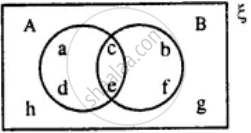
From the given diagram find :
A - B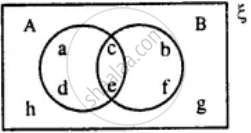
From the given diagram find :
B - A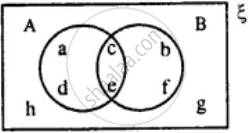
From the given diagram find :
(A ∪ B)'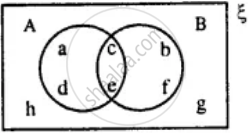
From the given diagram, find:
(i) A’
(ii) B’
(iii) A' ∪ B'
(iv) (A ∩ B)'
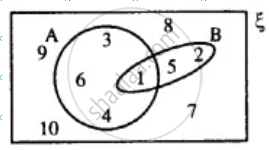
Is A' ∪ B' = (A ∩ B)' ?
Also, verify if A' ∪ B' = (A ∩ B)'.
Use the given diagram to find:
(i) A ∪ (B ∩ C)
(ii) B - (A - C)
(iii) A - B
(iv) A ∩ B'
Is A ∩ B' = A - B?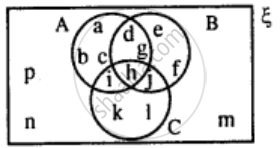
Use the given Venn-diagram to find:
B - A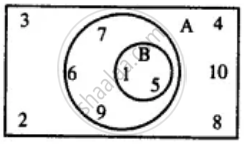
Use the given Venn-diagram to find :
A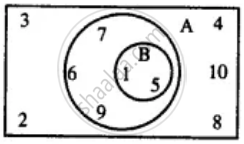
Use the given Venn-diagram to find :
B'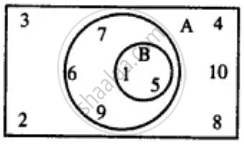
Use the given Venn-diagram to find :
A ∩ B
Use the given Venn-diagram to find :
A ∪ B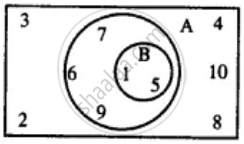
Draw a Venn-diagram to show the relationship between two overlapping sets A and B. Now shade the region representing :
A ∩ B
Draw a Venn-diagram to show the relationship between two overlapping sets A and B. Now shade the region representing :
A ∪ B
Draw a Venn-diagram to show the relationship between two overlapping sets A and B. Now shade the region representing :
B - A
Draw a Venn-diagram to show the relationship between two sets A and B; such that A ⊆ B, Now shade the region representing :
A ∪ B
Draw a Venn-diagram to show the relationship between two sets A and B; such that A ⊆ B, Now shade the region representing :
B' ∩ A
Draw a Venn-diagram to show the relationship between two sets A and B; such that A ⊆ B, Now shade the region representing :
A ∩ B
Draw a Venn-diagram to show the relationship between two sets A and B; such that A ⊆ B, Now shade the region representing :
(A ∪ B)'
Two sets A and B are such that A ∩ B = Φ. Draw a venn-diagram to show the relationship between A and B. Shade the region representing :
A ∪ B
Two sets A and B are such that A ∩ B = Φ. Draw a venn-diagram to show the relationship between A and B. Shade the region representing :
(A ∪ B)'
Two sets A and B are such that A ∩ B = Φ. Draw a venn-diagram to show the relationship between A and B. Shade the region representing :
B - A
Two sets A and B are such that A ∩ B = Φ. Draw a venn-diagram to show the relationship between A and B. Shade the region representing :
B ∩ A'
State the sets representing by the shaded portion of following venn-diagram :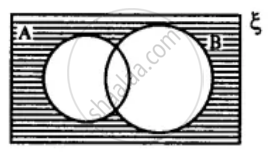
State the sets representing by the shaded portion of following venn-diagram :
State the sets representing by the shaded portion of following venn-diagram :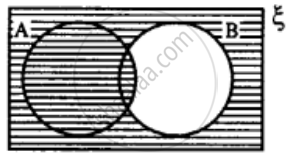
In the given diagram, shade the region which represents the set given underneath the diagrams: (B - A)'
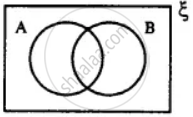
In the given diagram, shade the region which represents the set given underneath the diagrams: (A ∩ B)'
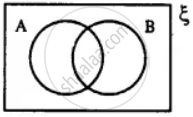
In the given diagram, shade the region which represents the set given underneath the diagrams: (P ∩ Q)'
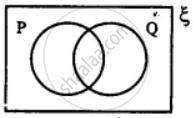
From the given diagram, find :
(i) (A ∪ B) - C
(ii) B - (A ∩ C)
(iii) (B ∩ C) ∪ A
Verify :
A - (B ∩ C) = (A - B) ∪ (A - C)

Using the given diagram, express the following sets in the terms of A and B. {a, d}
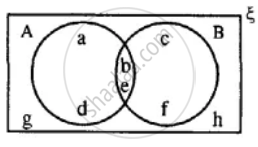
Using the given diagram, express the following sets in the terms of A and B. {a, d, c, f}
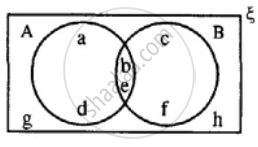
Using the given diagram, express the following sets in the terms of A and B. {a, d, c, f, g, h}
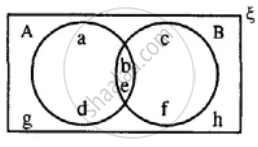
Using the given diagram, express the following sets in the terms of A and B. {a, d, g, h}
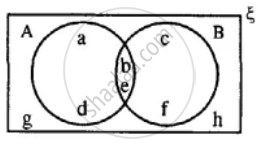
Using the given diagram, express the following sets in the terms of A and B. {g, h}
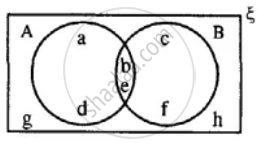
Solutions for 6: Sets
![Selina solutions for Concise Mathematics [English] Class 8 ICSE chapter 6 - Sets Selina solutions for Concise Mathematics [English] Class 8 ICSE chapter 6 - Sets - Shaalaa.com](/images/concise-mathematics-english-class-8-icse_6:3b78c4422443458583dde48f228ef792.jpg)
Selina solutions for Concise Mathematics [English] Class 8 ICSE chapter 6 - Sets
Shaalaa.com has the CISCE Mathematics Concise Mathematics [English] Class 8 ICSE CISCE solutions in a manner that help students grasp basic concepts better and faster. The detailed, step-by-step solutions will help you understand the concepts better and clarify any confusion. Selina solutions for Mathematics Concise Mathematics [English] Class 8 ICSE CISCE 6 (Sets) include all questions with answers and detailed explanations. This will clear students' doubts about questions and improve their application skills while preparing for board exams.
Further, we at Shaalaa.com provide such solutions so students can prepare for written exams. Selina textbook solutions can be a core help for self-study and provide excellent self-help guidance for students.
Concepts covered in Concise Mathematics [English] Class 8 ICSE chapter 6 Sets are Concept of Sets, Representation of a Set, Cardinal Number of a Set, Types of Sets, Subset, Proper Subset, Number of Subsets and Proper Subsets of a Given Set, Super Set, Universal Set, Set Operations, Difference of Two Sets, Distributive Laws, Complement of a Set, Venn Diagrams.
Using Selina Concise Mathematics [English] Class 8 ICSE solutions Sets exercise by students is an easy way to prepare for the exams, as they involve solutions arranged chapter-wise and also page-wise. The questions involved in Selina Solutions are essential questions that can be asked in the final exam. Maximum CISCE Concise Mathematics [English] Class 8 ICSE students prefer Selina Textbook Solutions to score more in exams.
Get the free view of Chapter 6, Sets Concise Mathematics [English] Class 8 ICSE additional questions for Mathematics Concise Mathematics [English] Class 8 ICSE CISCE, and you can use Shaalaa.com to keep it handy for your exam preparation.
